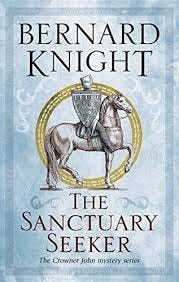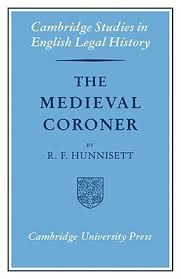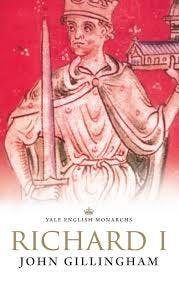The Developing State: The Office of Coroner, 1194
Historical fiction can be a window for people to explore the past. Such is the case for yours truly regarding this post. The books in question are Bernard Knight’s historical mystery series, Crowner John. The protagonist is a fictional coroner or crowner for Devon, Sir John de Wolfe. The action of the stories takes place during the last decade of the twelfth century during the reign of Richard the Lionheart (r. 1189-99). While these mysteries remain a fun read, they were also my introduction to the medieval office of coroner, the ancestor of the modern coroner. Indeed, such was my interest that the original idea for my PhD dissertation was to focus on the coroner in the thirteenth and fourteenth centuries. However, that idea soon proved to be both too broad and too slippery as a topic. Eventually, I moved onto the Duchy of Lancaster, where my dissertation is now focused (to de defended next year in all hope!). My interest in the coroner has not disappeared, however, and I hope to return to the topic in future projects.
For this entry in my series on the developing state of England, I thought I would introduce you to the coroner, his official duties, and why the role was instituted to begin with. The office of coroner was proclaimed in a judicial assize of September 1194 of King Richard I (the Lionheart). Three knights and a clerk were to be chosen for every county in England to keep the pleas of crown.[1] There is some discrepancy whether the coroners were a straightforward innovation in 1194. Historian Alfred Poole presented evidence that the office was already in existence during the reign of Richard’s father, Henry II (r. 1154-89), in certain English counties.[2] There are even claims that coroners existed as far back as Anglo-Saxon England during the reign of Alfred the Great (r. 871-99). Regardless of whether it was fully novel or not, the office proved a permeant addition to the local government of England after 1194.
The coroner had three main responsibilities. His primary one, as it is now, was to hold an inquest on the bodies of those who died suddenly, whether by accident or murder. The inquest was to include representatives of the four townships near the area where the dead body was found. The findings of the inquest were to be recorded on the coroner’s rolls for presentation to the king’s justices when they arrived to try outstanding cases and to serve as records of events at the local county court. Secondly, the coroners were to take the confessions of those in sanctuary within a church who wished to abjure or leave England in exile. Thirdly, they looked after the crown’s interests in the county. This could include valuing the chattels of a suspected murderer in case the latter was to be executed for his crime. If he were, his goods would be confiscated by the crown. The coroner also had to set a price on any object which accidentally caused the death of someone, such as a horse, boat, or even a brick.[3] Finally, and this has always remained my favourite, the coroner took charge of any wrecked ships or discovered treasure troves for the crown.[4]
However, one suspects that Richard I and his justiciar or chief minister, Hubert Walter, archbishop of Canterbury, had other reasons for installing coroners in each county.[5] One was undoubtedly for the coroner to act as a check on the chief royal officer for the county, the sheriff. Anyone familiar with the tales of Robin Hood knows that medieval sheriffs could act quite brazenly and sometimes ride roughshod over the rights and interests of local society. Additionally, the coroners’ inquests would divert more cases into the emerging system of royal courts which mean more money in confiscated property and legal fines (or amercements) for the crown. And as both historians and the Crowner John mysteries repeatedly relate, Hubert Walter needed every coin he could find for the Lionheart’s war to reclaim his lands from the king of France.
The office of coroner continued as the Middle Ages progressed.[6] It was one of the few medieval English offices that was an elected, though the king ordered the election and the electorate was a small one.[7] As local government evolved, the coroner gradually ceased to be the law office it began life as and became the medical officer so well-known from modern police procedurals. The office of coroner is one of the items of the developing state that one can still conjure with. A medieval office with a modern relevance.
Further Reading for the Medieval Coroner
The major work on the coroner remains R. F. Hunnisett, The Medieval Coroner (Cambridge, 1961).
For a more recent title that looks at the coroner from a joint criminal and medical perspective, see S. Butler, Forensic Medicine and Death Investigation in Medieval England (Routledge, 2014).
For a collection of coroners’ inquests from the fourteenth century, see Calendar of Coroners Rolls of the City of London, AD 1300-1378, ed. R. R. Sharpe (Suffolk, 1913).
If one is interested in seeing maps with detailed information from the coroners’ inquests for the cities of London, Oxford, and York, the website The Coroner and His Rolls - Medieval Murder Maps makes for fascinating reading.
[1] Select Charters and Other Illustrations of English Constitutional History from the Earliest Times to the Reign of Edward I, ed. W. Stubbs, 9th edition revised by H. W. C. Davis (Oxford, 1921), 30, 254. The Latin is Praeterea in quolibet comitatu eligantur tres milites et unus clericus custodes placitorum coronae.
[2] A. L. Poole, From Domesday Book to Magna Carta, 1087-1216 (second edition, Oxford, 1955), 390-1 n. 2. There also seems to have been coroners in Normandy as early as 1171. Normandy was one of the domains of the house of Plantagenet in France at the time.
[3] The purpose here was to give the evaluated sum as a gift to God for charity or deodand.
[4] Poole, Domesday Book to Magna Carta, 391.
[5] J. Gillingham, Richard I (London and New Haven, 1999), 274-82.
[6] For the coroner in the fourteenth century, see The English Government at Work, 1327-1336 III: Local Administration and Justice, ed. J. F. Willard, W. A. Morris, and W. H. Dunham, Jr. (Cambridge, MA, 1950), 149-65.
[7] For an example of an order to elect a coroner in the reign of Edward I (r. 1272-1307) see Calendar of Close Rolls 1279-1288, 85: Calendar of the Close rolls preserved in the Public record office. Prepared under the superintendence of the deputy keeper of the records : Great Britain. Public Record Office : Free Download, Borrow, and Streaming : Internet Archive





Hello friend, I’m trying to find new interesting writers, so I thought I’d introduce myself with an article.
Hope that’s okay, pleasure to meet you.
https://open.substack.com/pub/jordannuttall/p/the-plague-in-asia?r=4f55i2&utm_medium=ios
Fascinating, never would have guessed the office went back that far.